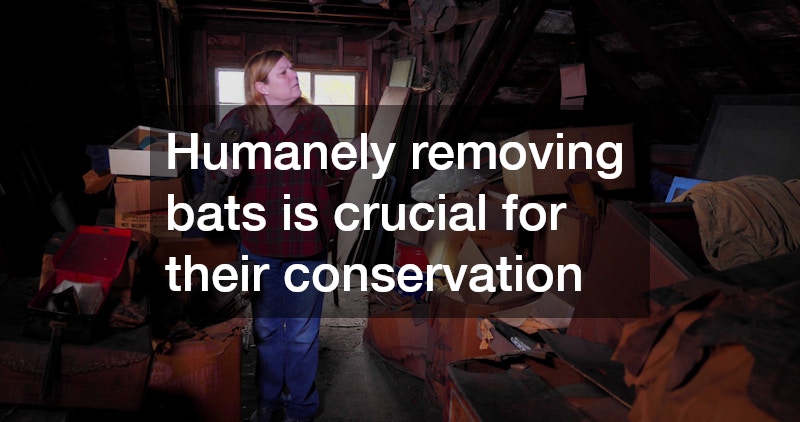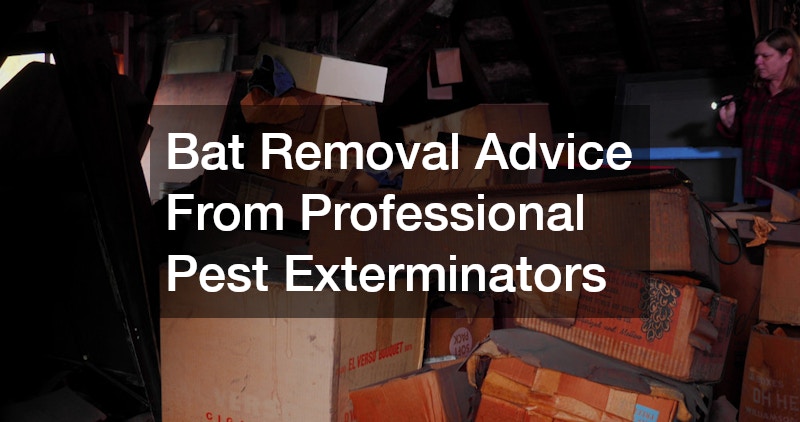It can be helpful to understand the answers to frequently asked questions about bat removal with insights from professional pest exterminators. Bats are essential for our ecosystem, but when they invade residential spaces, it can lead to significant concerns. Understanding how to approach bat removal can protect both the bats and your home, ensuring a safe environment for all.
Signs of a Bat Infestation
There are several common indicators that suggest the presence of bats in your home or property. Nocturnal sounds such as squeaking, chirping, or rustling noises, especially at dusk or dawn, can signify a bat presence.
Homeowners may also notice unusual odors and droppings reminiscent of mouse feces located near entry points like windows or attics.
Stains or marks on walls and ceilings can also indicate bats’ roosting sites. These stains are often dark streaks caused by the oils in a bat’s fur. Additionally, homeowners may observe bats flying near their homes, especially during twilight hours, which can be another key signal of an infestation.
Identifying these signs early can help mitigate any serious problems. Monitoring your home during peak bat activity times can help in recognizing potential infestations before they escalate. Proper inspection methods can reveal hidden entry points that require attention for later removal and prevention strategies.
Ethics Surrounding Bat Removal
Bats are a protected species in many areas, making it essential to employ humane methods during removal. Inhumane practices can lead to criminal charges or fines, thereby emphasizing the importance of understanding the appropriate methods for handling bats.
Humanely removing bats is crucial for their conservation, as these creatures play vital roles in pollination and pest control. Preserving bat populations also contributes to the ecological balance in natural environments. Educating homeowners about the benefits of bats aids in garnering support for humane treatment in pest control practices.
Understanding local laws and guidelines assists pest exterminators in performing safe, humane removals. Reliable methods include exclusion and relocation techniques rather than lethal measures. By prioritizing humane removal, we can respect wildlife and promote coexistence with these important creatures.
Risks Associated With Bats
Understanding the health risks that can arise from bat infestations is essential for homeowners. Bats are known carriers of rabies, a potentially fatal disease that can be transmitted through bites or saliva. While the risk is relatively low, any exposure should prompt immediate medical attention.
Histoplasmosis is another significant health concern associated with bat infestations. This fungal disease can arise from bat droppings and pose severe respiratory problems for sensitive individuals. Awareness of these health risks provides further incentive for proactive bat management strategies.
In addition to health risks, bats can also cause considerable property damage. Their droppings can corrode roofing materials and cause structural issues over time. Homeowners should not underestimate the financial implications of bat infestations, thus reinforcing the need for timely intervention and expert assistance.
Methods for Bat Removal
Exploring effective techniques used by professional pest exterminators reveals the most reliable methods for safely removing bats from premises. Exclusion methods, which involve sealing entry points, are favored as they compel bats to leave without causing harm. It is critical to identify all possible access points before initiating removal.
Another common technique is the use of one-way exit devices, which allow bats to exit but prevent them from returning. This method is both humane and effective, as it encourages bats to relocate to a suitable habitat without harm. Professionals often schedule these removals during specific seasons to align with bat behavior patterns.
Additionally, hiring licensed professionals ensures adherence to local regulations and ethical considerations. These experts are equipped with knowledge and tools to evaluate each situation and enact appropriate, efficient removal strategies. A comprehensive bat removal plan can safeguard properties from future infestations as well.
Tactics for Future Prevention
Proactive measures homeowners can take to make their properties less attractive to bats are essential for long-term prevention. Sealing entry points is crucial; small cracks and openings can easily become access routes for bats. Regular inspections of roofs, attics, and basements can help identify potential vulnerabilities.
Proper maintenance of outdoor lighting can also play a role in deterrence. Bats are attracted to insects, so reducing outdoor lighting can minimize moth populations, thus discouraging bats from roosting nearby. Landscaping can further improve the effectiveness of preventive measures by ensuring that trees and shrubs near the home don’t provide easy access.
Regular engagements with pest management services can help homeowners stay informed about best practices and updates on local regulations. Understanding the ecological benefits of bats can encourage more harmonious strategies for coexistence, reducing the likelihood of future encounters with these fascinating yet sometimes problematic creatures.
Bat removal is a serious concern that should be addressed promptly and humanely. By understanding the signs of infestation, the risks involved, removal methods, and preventive measures, homeowners can protect their properties and ensure a safe living environment. Fostering a balance between human habitation and wildlife conservation is essential for the ecosystem.

